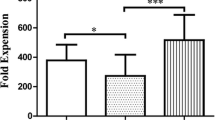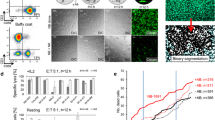Summary
In phase-I clinical trials of adoptive immunotherapy using lymphokine-activated killer (LAK) cells plus recombinant interleukin-2 (rIL-2) (Cetus) for the treatment of malignant glioma, we observed that blood mononuclear cells (MNC) from patients dependent on dexamethasone for management of cerebral edema produced substantially less LAK activity as compared to MNC of normal blood donors or glioma patients not receiving steroid therapy. Therefore, we examined the in vitro effects, brought about by therapeutically attainable concentrations of various corticosteroids, on the proliferative response, production of γ interferon (IFN-γ), and induction of LAK activity from blood MNC of normal donors. Incubation in media containing rIL-2 (1000 U/ml) with either dexamethasone, hydrocortisone, methylprednisolone, or prednisolone profoundly affected all of these parameters. First, while 0.01 μg/ml of either dexamethasone or hydrocortisone caused a slight enhancement of the mitogenic response of lymphocytes to phytohemagglutinin, a dose-dependent decline occurred as concentrations increased to 10 μg/ml. The addition of prednisolone and methylprednisolone elicited a dose-dependent inhibition of lymphocyte proliferation over the entire concentration range tested. At 0.1 μg/ml or higher, dexamethasone, hydrocortisone, methylprednisolone and prednisolone significantly (P<0.02) inhibited the production of IFN-γ: respectively 18.9%, 4.4%, 2.2%, and 12.3% of the IFN-γ produced by MNC in the absence of steroids. All four corticosteroids inhibited the induction of LAK activity. Compared to MNC that had been incubated with 1000 U/ml rIL-2 alone, MNC cultured with rIL-2 and 10 μg/ml either dexamethasone or prednisolone demonstrated significantly lower cytotoxicity (P<0.05) for the natural-killer-cell-resistant cell line, Daudi. Culturing MNC with hydrocortisone had a more dramatic result, causing a significant decline (P<0.01) in lytic activity at both 1.0 μg/ml and 10 μg/ml, while incubation with methylprednisolone produced a significant drop (P<0.02) in LAK-mediated cytotoxicity at 0.1 μg/ml as well as 1.0 μg/ml and 10 μg/ml. When cytotoxicity was expressed as lytic units per million effectors, a dose-response decline in lytic activity was once again apparent, with hydrocortisone, methylprednisolone and prednisolone showing significant inhibition (P<0.05) at both 1.0 μg/ml and 10 μg/ml and dexamethasone at 10 μg/ml (P<0.01). These results indicate that corticosteroids commonly used in the management of cerebral tumors and other malignancies inhibit induction of LAK activity in vitro, and this may explain why it is often difficult to generate LAK activity from blood MNC of patients who are receiving chronic steroid therapy.
Similar content being viewed by others
References
Apuzzo MLJ, Mitchell MS (1981) Immunological aspects of intrinsic glial tumors. J Neurosurg 55:1
Arya SK, Wong-Staal F, Gallo RC (1984) Dexamethasonemediated inhibition of human T cell growth factor and gamma-interferon messenger RNA. J Immunol 133:273
Bosnes V, Hirschberg H (1988) Comparison of in viro glioma cell cytotoxicity of LAK cells from glioma patients and healthy donors. J Neurosurg 69:234
Braughler JM, Hall ED (1985) Current application of “high-dose” steroid therapy for CNS injury. A pharmacological perspective. J Neurosurg 62:806
Cotran RS, Pober JS, Gimbrone MA, Springer TA, Wiebke EA, Gaspari AA, Rosenberg SA, Lotze MT (1988) Endothelial activation during interleukin 2 immunotherapy. A possible mechanism for the vascular leak syndrome. J Immunol 140:1883
Cox WI, Holbrook NJ, Grasso RJ, Spector S, Friedman H (1982) Suppression of the natural killer cell activity of murine spleen cell cultures by dexamethasone. Proc Soc Exp Biol Med 171:146
DeWeck AL, Kristensen F, Joncourt F, Bettens F, Walker C, Wang Y (1984) Lymphocyte proliferation, lymphokine production, and lymphocyte receptors in aging and various clinical conditions. Springer Semin Immunopathol 7:273
Farrar WL, Johnson HM, Farrar JJ (1981) Regulation of the production of immune interferon and cytotoxic T lymphocytes by IL-2. J Immunol 126:1120
Fauci AS (1979) Immunosuppressive and anti-inflammatory effects of glucocorticoids. In: Baxter JD, Rousseau GG (eds) Glucocorticoid hormon action. Springer-Verlag, Berlin, 449
Frey BM, Walker C, Frey WF, de Weck AL (1984) Pharmacokinetics and pharmacodynamics of three different prednisolone prodrugs: effect on circulating lymphocyte subsets and function. J Immunol 133:2479
Goto T, Herberman RB, Maluish A, Strong DM (1983) Cyclic AMP as a mediator of prostaglandin E-induced suppression of human natural killer cell activity. J Immunol 130:1350
Grimm EA (1986) Human lymphokine-activated killer cells (LAK cells) as a potential immunotherapeutic modality. Biochim Biophys Acta 865:267
Grimm EA, Muul LM, Wilson DJ (1985) The differential inhibitory effects exerted by cyclosporine and hydrocortisone on the activation of human cytotoxic lymphocytes by recombinant interleukin-2 versus allospecific CTL. Transplantation 39:537
Hatam A, Yu Z-Y, Bergstrom M, Berggren B-M, Greitz T (1982) Effect of dexamethasone treatment on peritumoral brain edema: evaluation by computed tomography. J Comput Assist Tomogr 6:586
Hirschberg H, Hirschberg I, Nousiainen H, Broothen LR, Jaffe E (1982) The effects of corticosteroids on the antigen-presenting properties of human monocytes and endothelial cells. Clin Immunol Immunopathol 23:577
Holbrook NJ, Cox WJ, Horner HC (1983) Direct suppression of natural killer activity in human peripheral blood leucocyte cultures by glucocorticoids and its modulation by interferon. Cancer Res 43:4019
Hossmann KA, Wechsler W, Wilmes F (1979) Experimental peritumorous edema. Morphological and pathophysiological observations. Acta Neuropathol 45:195
Itoh K, Shiiba K, Shimizu Y, Suzuki R, Kumagai K (1985) Generation of activated killer (AK) cells by recombinant IL 2 in collaboration with interferon-gamma. J Immunol 134:3124
Jacobs SK, Kornblith PL, Wilson DJ, Grimm EA (1986) In vitro killing of human glioblastoma by interleukin-2-activated autologous lymphocytes. J Neurosurg 64:114
Jacobs SK, Wilson DJ, Kornblith PL, Grimm EA (1986) Interleukin-2 or autologous lymphokine-activated killer cell treatment of malignant glioma: phase I trial. Cancer Res 46:2101
Jarden JO, Dhawan V, Poltorak A, Posner JB, Rottenberg DA (1985) Positron emmission tomographic measurement of blood-to-brain and blood-to-tumor transport of 82Rb: the effect of dexamethasone and whole-brain radiation therapy. Ann Neurol 18:636
Klatzo I (1967) Neuropathological aspects of brain edema. J Neuropathol Exp Neurol 26:1
Larsson EL (1980) Cyclosporin A and dexamethasone suppress T cell response by selectively acting at distinct sites of the triggering process. J Immunol 124:2828
Leenders KL, Beaney RP, Brooks DJ, Lammertsma AA, Heather JD, McKenzie CG (1985) Dexamethasone treatment of brain tumor patients: effects on regional cerebral blood flow, blood volume, and oxygen utilization. Neurology 35:1610
Merchant RE, Grant AJ, Merchant LH, Young HF (1988) Adoptive immunotherapy for recurrent glioblastoma multiforme using lymphokine activated killer (LAK) cells and recombinant interleukin-2. Cancer 62:665
Merchant RE, Merchant LH, Cook SHS, McVicar DW, Young HF (1988) Intralesional infusion of lymphokine-activated killer (LAK) cells and recombinant interleukin-2 (rIL-2) for the treatment of patients with malignant brain tumor. Neurosurgery 23:725
Meuleman J, Katz P (1985) The immunologic effects, kinetics, and use of glucocorticosteroids. Med Clin N Am 69:805
Miller JD, Skalar R, Ward J, Young HF, Adams WE, Vries JK, Becker DP (1977) Methylprednisolone treatment in patients with brain tumors. Neurosurgery 1:114
Neuwelt EA, Kikuchi K, Hill S, Lipsky P, Frenkel EP (1983) Immune responses in patients with brain tumors. Factors such as anticonvulsants that may contribute to impaired cell-mediated immunity. Cancer 51:248
Papa MZ, Vetto JT, Ettinghausen SE, Mule JJ, Rosenberg SA (1986) Effects of corticosteroid on the antitumor activity of lymphokine activated killer and interleukin-2 in mice. Cancer Res 46:5618
Pedersen BK, Beyer JM (1986) Characterization of the in vitro effects of glucocorticosteroids on NK activity. Allergy 41:220
Reed JC, Abidi AH, Alpers JD, Hoover RG, Robb RJ, Nowell PC (1986) Effect of cyclosporin A and dexamethasone on interleukin 2 receptor gene expression. J Immunol 137:150
Reichman HR, Farrell CL, Del Maestro RF (1986) Effects of steroids and nonsteroidal anti-inflammatory agents on vascular permeability in a rat glioma model. J Neurosurg 65:233
Rosenberg SA (1985) Lymphokine-activated killer cells: a new approach to immunotherapy of cancer. J Natl Cancer Inst 75:595
Rosenberg SA, Lotze MT, Muul LM, Leitman S, Chang AE, Vetto JT, Seipp CA, Simpson C (1985) A new approach to the therapy of cancer based on the systemic administration of autologous lymphokine-activated killer cells and recombinant interleukin-2. New Engl J Med 313:1485
Schaffner A, Schaffner T (1987) Glucocorticoid-induced impairment of macrophage antimicrobial activity: mechanisms and dependence on the state of activation. Rev Infect Dis 9: S620
Selker RG, Moore P, Odachowski S (1979) Corticosteroid therapy in the management of gliomas. In: Paoletti P, Walker MD, Knerich R (eds) Multidisciplinary aspects of brain tumor therapy. Elsiver/North-Holland Biomedical Press, p 143
Shiiba K, Suzuki R, Kawakami K, Ohuchi A, Kumagai K (1986) Interleukin 2-activated killer cells: generation in collaboration with interferon and its suppression in cancer patients. Cancer Immunol Immunother 21:119
Snyder DS, Unanue ER (1982) Corticosteroids inhibit murine macrophage Ia expression and interleukin-1 production. J Immunol 129:1803
Talmadge JE (1985) Immunoregulation and immunostimulation of murine lymphocytes by recombinant human interleukin-2. J Biol Resp Modif 4:18
Tracey DE, Hardee MM, Richard KA, Paslay JW (1988) Pharmacological inhibition of interleukin-1 activity on T cells by hydrocortisone, cyclosporine, prostaglandins, and cyclic nucleotides. Immunopharmacol 15:47
Vetto JT, Papa MZ, Lotze MT, Chang AE, Rosenberg SA (1987) Reduction of toxicity of interleukin-2 and lymphokine-activated killer cells in humans by administration of corticosteroids. J Clin Oncol 5:496
Waage A, Bakke O (1988) Glucocorticoids suppress the production of tumour necrosis factor by lipopolysaccharide-stimulated human monocytes. Immunology 63:299
Yamada S, Ortaldo JR (1987) Regulation of large granular lymphocytes and human T cell growth and function by recombinant interleukin 2. II. Acquisition of potent cytotoxic capabilities. J Leukocyte Biol 42:263
Yamada K, Bremer AM, West CR (1979) Effects of dexamethasone on tumor-induced brain edema and its distribution in the brain of monkeys. J Neurosurg 50:361
Yamada K, Ushio Y, Hayakawa T, Arita N, Yamada N, Mogami H (1983) Effects of methylprednisolone on peritumoral brain edema: a quantitative autoradiographic study. J Neurosurg 59:612
Yoshida S, Tanaka R, Takai N, Ono K (1988) Localadministration of autologous lymphokine-activated killer cells and recombinant interleukin 2 to patients with malignant brain tumors. Cancer Res 48:5011
Author information
Authors and Affiliations
Rights and permissions
About this article
Cite this article
McVicar, D.W., Merchant, R.E., Merchant, L.H. et al. Corticosteroids inhibit the generation of lymphokine-activated killer activity in vitro. Cancer Immunol Immunother 29, 211–218 (1989). https://doi.org/10.1007/BF00199998
Received:
Accepted:
Issue Date:
DOI: https://doi.org/10.1007/BF00199998




